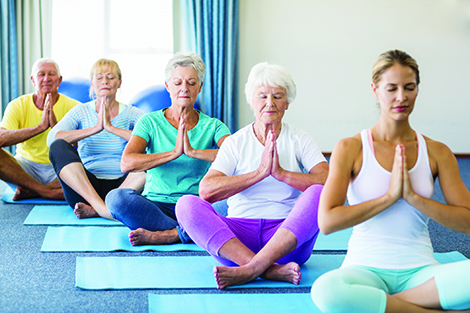By Dinelli Monson and Amanda Rees
While we continue to study and gather data about the second-order impacts of COVID-19, it’s becoming clear that the pandemic exacerbated risk factors for falls among older adults like physical inactivity. For this reason, it is vital for older adults to know that support is available that can help reduce their risk for falls and improve their quality of life.

according to the 2021 America’s Health Rankings Senior Report. In Washington, 27 percent of adults 65 and older reported a fall in the past year, the report showed.
Falls present a more significant health threat than many realize, and, for older adults, they can take a serious toll on quality of life, independence, and overall well-being. While the risk of falls increases for older adults, falls aren’t a normal part of aging and pose a serious public health concern.
While contributing factors for falls like physical inactivity, obesity, and alcohol abuse were exacerbated by COVID-19, other risk factors include arthritis, poor balance and vision, certain medications, osteoporosis, certain disabilities, and general frailty. Older adults with arthritis, a common driver of disability, are more than twice as likely to experience a fall.
Recent data from the national Centers for Disease Control and Prevention (CDC) show falls are the leading cause of injury and ER visits for adults 65 and older. One in four older adults fall each year, costing more than $50 billion annually. And that cost is projected to increase to $100 billion by 2030.
As a physician and a leader in healthy aging, we have each seen firsthand the impact of falls on patients and loved ones. Falls too often lead to a cascade of health challenges and a decrease in quality of life. An older adult who suffers a fall may not be able to enjoy the same activities as before like gardening, sports, or other hobbies.
To help address these challenges, Age Bold and UnitedHealthcare are working together in Washington to provide fitness programs at no additional cost for eligible UnitedHealthcare Medicare plan members and to raise awareness of risk factors for falls among older adults. Proper exercise can reduce risks for falls by improving strength and balance.
Eligible UnitedHealthcare Medicare plan members will be able to access Age Bold’s healthy-aging exercise classes online through UnitedHealthcare’s Renew Active fitness program. Once enrolled, these members receive weekly live and on-demand classes, support from the Age Bold community, and assessments to measure strength, balance, and mobility at-home. Age Bold offers a variety of options, including tai chi, yoga, strength training, dance and cardio, taught by expert instructors. Research has found that Age Bold’s falls-prevention and balance classes can reduce the incidence of falls up to 46 percent.
In addition to exercise, the CDC has resources and tips for reducing risk for falls, including speaking openly with a physician, having eyes and feet checked, and removing obstacles in the home that could pose a tripping hazard.
COVID-19 caused a shift in consumer demand for flexible, simple, and convenient options to access healthcare and the resources to live a healthier life. It’s more important than ever to support the older adults in our communities with the resources they need to stay on their feet and maintain the quality of life they deserve.
Dr. Dinelli Monson is chief medical officer for UnitedHealthcare Medicare and Retirement of Washington. Amanda Rees is chief executive officer of Age Bold.
SOME HEALTH PLANS MIGHT PAY FOR YOUR EXERCISE
According to the national Centers for Disease Control, exercise prevents bone loss, relieves osteoarthritis pain, helps prevent chronic diseases, boosts immunity, and improves moods.
To help add exercise to the lifestyles of older adults, some Medicare Advantage plans will cover gym memberships at no extra charge, along with health and fitness programs like My Plate (a nutrition guide published by the U.S. Department of Agriculture), Eat Right (a program of the Academy of Nutrition and Dietetics), and SilverSneakers, which offers online and in-person exercise classes. Gym memberships or fitness programs may also be part of Medicare Supplement Insurance (Medigap) plans.
The National Council on Aging notes forms of exercise that are particularly ideal for older adults include yoga (low-impact, strengthens muscles, core and bones) and Pilates (improves balance and flexibility, reduces symptoms of arthritis).
Here are a few facts to back up the exercise-is-good mantra:
- 83 percent of Silver Sneakers participants engage in aerobic activity three or more times per week.
- The percentage of Silver Sneakers adherents doing the same amount of weekly participation in muscle strengthening and flexibility exercises is 65 percent and 49 percent, respectively.
- During the COVID-19 pandemic, seniors 65 and older have been averaging 100 more minutes of weekly activity than those in the preceding age group, according to a study reported in Canadian Running Magazine.
Sources: Medicare.gov and Ensurem, an insurance marketing and technology company.